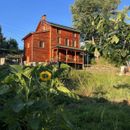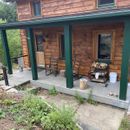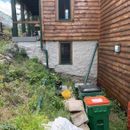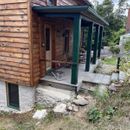Sand Used as Fill
At my harvest homestead house, I finally pulled up a plywood board constituting part of my older front porch to discover why the stone retaining wall underneath it is always so wet! What do I discover? Sand. Lots of it used as fill probably 100 years ago. Sand keeps water, so it needs to be removed as far as I understand. (Yes?) Next steps? I’m thinking bentonite clay at the base of the dug-out exterior of the stone wall, including a channel for water to be piped out from the base. Fill with gravel? May not even be necessary to slather the exterior of the stone wall with bentonite as the porch is above and drainage will end up below? I suppose I could take another step and somehow insulate outboard? As I’m a nontoxic (petrol-free, etc.) professional, I could see Roxul (or something else good with waterlogging) up against the exterior of the stone wall? Probably not worth it, as the stone wall continues around the corners for a spell – so temp-control benefits would be very limited. Still – better than nothing? Mmm Thanks for your consideration. Beacon, NY
GBA Detail Library
A collection of one thousand construction details organized by climate and house part














Replies
Gregg,
Sand doesn't hold water so much as it allows water to flow easily into/through it. Dunes at the beach are pretty dry until you get near the tidal level. Sand point wells are common around lakes for the reason that water will flow readily to the well point, the sand provides filtration. If the sand is wet, then finding the source of the water will guide your plans.
Is the first photo of your "front" porch under the elevated porch seen in the second photo? If not then is the front porch located on the unseen and up hill side of the house? I ask because my prior home was situated on a hill much the same way. All the surface water, and I suspect a good bit of ground flow, came at the uphill corner of the basement block walls. Those two walls were very wet. The water that settled down the walls popped up in my basement as a perpetual though weak fountain.
Further compounding the problem was a severed clay tile pipe meant to take the downspout flow to a cistern located behind the house and below basement floor level. The county in its infinite wisdom made all such cisterns illegal in the 60's. The tile was severed just beyond the downhill house wall and the cistern was filled with dirt. Of course the tile still directed the downspout water toward the cistern and net result was a soggy soft spot under the parking apron in front of the garage.
You may be battling unseen paths and/or pipes that once fed a similar cistern. Hopefully they would not have put it up hill of the house, but one seldom knows the history of such features. You might have buried foundations to outbuildings that act as pooling sources. You reference a retaining wall that extends to either side of the "porch", is this part of a stone foundation. The photo suggests a half buried basement and three living floors. Some more photos would be helpful in orienting the walls and grades.
Getting rid of the water pathways feeding the sand will do you the most good. Bentonite on the walls may inadvertently block other water from exiting from inside the foundation. Particularly if it is a stone foundation. I have not had a chance to experiment with Roxul board to test whether it is water open as well as vapor open. It may be hydrophobic, but if immersed in water will it just become a soggy wall barrier without very free and clear drainage at the footing?
As to the word gravel, I may be suffering from a regionlism, but gravel in my past was simply a very coarse grade of sand and small stones. I grew up in an abandoned sand and gravel pit formed by glacial deposits, which made for a very vast sandbox for me and an excellent store of assorted sand and gravel for making mortar and concrete for my father. If you mean washed small rock bedding for drainage then going to the trouble of digging down may be the simplest course of action. Fabric wrapped of course. Unless you have insulated all the other walls or intend to, then I wouldn't bother with Roxul or foam. Roxul does consume a lot of energy from sources that can be as much a problem as the foam.
More details of the landscape and water shed would be the most helpful first step.
Thanks, onslow!
I added a few more pictures for lots more context. Your insights are very helpful.
I think what's most confusing to me is the fact that the top right of the stone retaining wall of the lower floor is taking the most beating - yet it's basically above ground! It's just under the front door, if that means anything. It's got lots of lime mortar failure... it's possible that it was most abused by frankenmortar - definitely the brick window frame was larded with frankenmortar, which ate away so much of the lime mortar as well as the brick itself. Over the weekend I can take a picture of that damage...
I'm only here to say you have such a terrific little house. Did you build it?
I coordinated the rehab, led the deconstruction, sourced carefully materials, and coordinated with contractors. Down to the studs and back up the olde house went. Just got another pine tar and linseed oil application last month on the clapboard. Such a challenge to skip petrol & frankenconcrete in the states, and I did my best.
I am worried you are digging in soil that was treated for termites with now banned chemicals they applied gallons of product and are likely to still be active.
The old school carpenters that built before pressure treated wood tended to keep the wood at least a foot above the soil.
Walta
Mistreated.
It's sand under the porch. Sand up against a stone retaining wall. Not soil.
New school carpenters still keep wood at least a foot above the soil!
Without diverting water away from the house there, you'll always have issues there. The problem isn't the sand, the problem is the hill. The proper solution is to dig around the foundation, waterproof and install weeping tile to drain somewhere downslope from the house.
The "this might work" option is a trench in front of your porch and slope dirt under the porch towards that trench. A layer of well compacted screening above sloped sand under the porch does a good job of channeling water away. The trench can then channel water from uphill and from the porch area to the sides where it can freely drain downhill.
The reason you are seeing mortar damage above grade is that is where the water is evaporating. The water moves into your foundation bellow grade, gets wicked up into it until eventually it gets above grade where it can evaporate. Most likely you are probably seeing a lot of effervescence there as well. To fix this, you need to keep the water out of your foundation.
P.S. Do not try to fill that area with gravel unless you do proper waterproofing. The grave will simply make this problem much worse as it will allow much more water to flow down to your foundation.
Really appreciate these insights, sir.
"bentonite clay at the base of the dug-out exterior of the stone wall, including a channel for water to be piped out from the base" is similar to "dig around the base of the foundation, waterproof, and install weeping tile to drain somewhere downslope from the house"!
So...
- create safe working conditions
- dig out sand and anything else to the base of the stone retaining wall
Question: placement of the Clay Drainage Pipes up against the base of the wall, yes? Can't completely stop water from entering the wall below grade completely; however, the wicking is mitigated by the drainage at the base of the wall...
- dig trench and run pipe away from wall to safe spot to expel liquids
- waterproof the wall exterior with bentonite clay?
- May be just use the same sand to refill the void?
The void filled with sand seems surrounded on three or four sides almost as a tub? Maybe the frankenconcrete pad out front of the porch is causing problems too? Or is it helping.
The hill out front brings in moisture to the retaining wall fundamentally. Waterproofing the exterior wall with bentonite layer and laying clay drainage piping outside the base to move more liquid away will manage adequately water conditions in the retaining wall. Look close enough? Thanks!
You want to waterproof the house wall, not the retaining wall. It definitely doesn't hurt to also install some drainage at the retaining wall to intercept some of the water coming down the hill.
Not sure if bentonite is the best, you want something that is moisture impermeable, an asphalt coating is a better option. With the amount of water you are probably seeing, a dimple mat is also a must. The weeping tile can be made using clay pipe as long as it is in clear crushed gravel bed and the dimple mat can drain into this area. Wrapping the gravel in geotextile to keep soil out is also a good idea.
The weeping tile is best located right beside the footing of the foundation. You want it as low as possible without undermining the foundation.
The concrete pad in front the porch should be sloped away from the house. Ideally it should drain into something (trench, storm drain channel or catch basin) to bring the water down to either side of the house.
They're the same thing: The "house wall" *is* the retaining wall.
Had a chat with a local builder, and we came up driving posts into the ground at the front of the porch to enable a retaining wall of sorts to be created after the void is created by digging the sand. I may leave the void, in fact - use it even as storage or the like.
Bentonite isn't the greatest and isn't the best; however, it's quite nontoxic and performs well among the rest: Petroleum is verboten here. Cheer(s)!
Your picture shows a retaining wall that supports the roof of your front porch. It looks like this forms a small "tub" around the porch that is filled with sand. Your house foundation wall is the inside edge of this tub. This is what you need to waterproof.
Hi, AKOS. The porch is supported by nothing except the sides, a latter day stone support, and the concrete front; as well, a connection to the house that never touches the foundation wall.
The foundation wall serves also as the wall for the lower floor interior.
Frankenconcrete pad... yes, slope away is one of the moves to make. Thanks again.